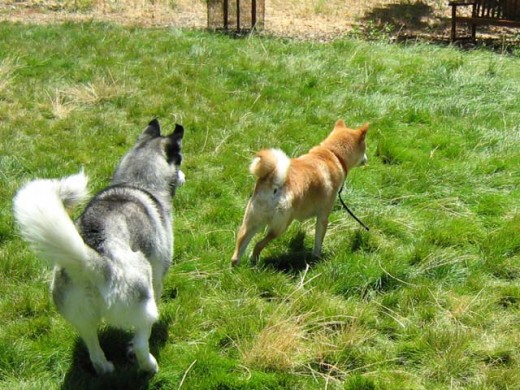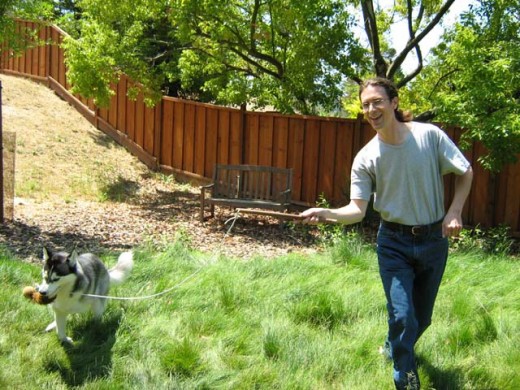Some time ago, I got an interesting comment from Ethan in my Dog Shock Collar article.
In his comment, Ethan makes some interesting claims –
- Zap-collars are way, way, way more humane than keeping your Sibe on a leash.
- Once he realized I could reach out and touch him no matter how far away I was from him, everything changed. Like magic.
- Huskies NEED TO RUN. If you can’t run them, you shouldn’t own one.

[Click here if you want to view Ethan’s full comment]
Let us consider each of these claims.
Huskies need to run
The claims that Ethan makes, are commonly made by many proponents of shock collars. They usually start their argument with some breed trait, for example, Siberian Huskies need to run. Indeed, Siberians are bred to RUN. Furthermore, Siberians are a very independent breed, with high prey drive. This makes it dangerous to let them run free.
Ethan’s well crafted claim, as I understand it, is as follows –
Siberians need to run and are independent. Therefore, they need the extra oomph of shock collars to ensure that they don’t run away. Furthermore, dog owners who are too soft to use shock collars, should not own a Siberian because then, the dog would not be able to run free.

Let us look at what the Siberian Husky Club of America (the AKC-recognized national breed club) has to say about this.
There is one final characteristic of the Siberian Husky which we must point out — their desire to RUN. There are many breeds of dogs which, when let out in the morning, will sit in the front yard all day. Not the Siberian Husky. His heritage has endowed him with the desire to run and his conformation has given him the ability to enjoy it effortlessly. But, one quick lope across a busy street could be the last run that he enjoys, ever. Because of this, we strongly urge that no Siberian Husky ever be allowed unrestrained freedom. Instead, for his own protection, he should be confined or under control at all times. Sufficient exercise for proper development and well-being may be obtained on a leash, in a large enclosure, or best of all, in harness. If you feel that it is inconvenient or cruel to keep a dog thus confined, then the Siberian Husky is not the breed for you.
~~ [Siberian Husky Club of America]
According to the National Siberian Husky breed club,
Sufficient exercise for proper development and well-being may be obtained on a leash, in a large enclosure, or best of all, in harness.
Shock collars are not a recommended option.

Shock Collars allow you to reach out and touch your dog, like magic.

Indeed, one of the advantages of shock collars is that they allow us to apply a pain stimulus to our dog from a distance.
However, it is not magic and it is not a touch.
Proponents of shock collars do not like to use the term shock or pain. Instead they refer to the electric current or shock as a touch. This magical touch, they say, does not cause any pain.
All scientific evidence show that this statement is false.
Shock collars work because they deliver a pain stimulus. The pain stimulus creates an aversive response in the dog which discourages him from a certain behavior, e.g. running away from us. Independent dogs with strong prey drive have an extremely strong instinct to hunt and chase. To trump this instinct, we must deliver a very strong shock.
Scientific studies by Schalke et al. also show that shock collars increase the stress levels in dogs after a period of just 7 days. Furthermore, stress levels were elevated as soon as the test dogs were returned to the shock treatment environment even though no shocks were administered.
According to Polsky’s study, dogs kept in shock containment systems (i.e. invisible fence or underground fence), showed extreme aggression towards humans, over and beyond their normal behavior.
Based on all this work and rigorous studies, we know the following facts –
- Shock collars can work. In fact, pain is a strong motivator.
- Shock collars work by delivering a pain stimulus. If they were not painful, they would not work. If all you want to do is get your dog’s attention, then use a whistle and not a shock collar.
- Shock collars are extremely risky, can increase aggression in dogs, and can cause elevated levels of stress. All this will result in a lower quality of life for the dog.
Shock collars are not magic and they do not deliver a touch. We may use terms like gentle training collar or gentle current but that does not change the true nature of shock collars. If we want to use a shock collar, then we should accept it for what it is.

Zap-collars are way, way, way more humane than keeping your Sibe on a leash.
The National Siberian Husky Club of America disagrees, the scientific data disagrees, and many qualified trainers disagree.

We have a deaf blue heeler. We have had great success and had to use the shock collar on him. We mostly have just used the vibrate setting but on rare occasions had to use the shock. We have been training with hand signals and light flashes at night but while he is still learning I wanted something that safeguarded him and humans when he would find trouble or start biting and getting out of control as young dogs can do. It was the only way we found to help because he couldn’t hear and unless he saw your hand signals we were without communication. I didn’t feel his life was diminished in anyway by using it. He is a well loved on dog but very hard to train without the collar.
I used a shock collar once on our Lab puppy, who was all-around disobedient. She jumped six inches into the air and looked so distressed that I took it off right away, realizing that I didn’t know what I was doing. That was 6 years ago and we have both gotten over the experience! She is a good dog now… Most of the time.
I have a pure bread Siberian Husky, she is 3 yrs old. She very quiet, loves the kids, such a sweet dog. We have a bug yard that we fenced so she could run and not be chained up, And I take her for daily walks/runs, depending on the day But she digs constantly and runs the town, or sometimes my kids leave the doors open so she gets out. She refuses to come when called, the only way of capturing her, is to corner her somewhere. I would like to use the shock collar to prevent her from digging and bolting out the door. I would not use the automatic one though, just a remote. I am using it as a last resort, and hoping it will help, because we have had people in the community threaten to shoot her, and shes such a good dog and part of our family. But she needs to learn not to run away.
One thing that worked really well with my Sibes wrt. digging is to place concrete blocks at the bottom of our fence line. One of my Huskies dug out once while chasing after some earth critter. After we put the concrete blocks in, there were no more escapes.
As for bolting out the door, one possibility is to put in a door that can swing shut on its own. Alternatively, we can put in a double door system, but I think the first option is easier.
As for recall training (come when called), here is a good list of techniques from the ASPCA-
http://www.aspca.org/Pet-care/virtual-pet-behaviorist/dog-articles/teaching-your-dog-to-come-when-called
Shock collars are risky, unreliable, and increases stress in our dogs. Many dogs still escape or do not come back even when the shocks are applied. Personally, I think the unreliable “results” are really not worth the associated risks.
I have a 7 year old, male, Siberian husky/border collie mix name wiley. We have been together since he was about 4 months old.
We have done a lot of obedience classes together and I have also been given training advice from those who train those amazing dogs in our United States Marine Corps.
Wiley and I both love to run and he always gets very excited when I start putting my running shoes on. Together, we clock in an average of 5 miles per day. In this case we are a perfect match. Therefore, I am sure he gets plenty of exercise.
He is friendly around people, kids and animals, never damages anything in my house even when I need to stay late at work, and he is smart. As long as we are in a confined area, he listens and instantly reacts to anything I say or ask. I move around a lot and travel a lot. In both cases he is always with me. He even travels on planes and stays in hotel rooms while I work. Every house I lived in he adjusted quickly, probably because we run a lot?
Wiley is the “Perfect dog”. Well almost…. He is a hit or miss off a leash. There are times while jogging in Central Park, I took the leash off and he stayed by my side the entire time. Lately, I have been hesitant because he does take off running and I chase him for about 30min. He doesn’t seem to listen when I call him. Realistically, he never really has when we are at the dog park, beach, or when he finds a way out of the house. Now I moved to a new house where I don’t have a fence and worried I may end up losing him. I have considered getting a sport shock collar with a GPS. The GPS to track him and the shock collar to stop him before he gets hit by a car.
I have read mixed reviews on e-collars, leaving me very confused. Should I get one?
Unless someone can suggest a better option then I think this may be my option? I am all ears.
Ultimately, I want what is best for both of us.
For something like the shock collar, I rely most on the findings of scientific studies. There have been many studies conducted on shock collars, and they show the following-
1. Shock collars increase stress levels in dogs in most instances.
2. The only case where shock collars do not increase stress is in very simple touch-aversion type training where there is a very direct and clear relationship between the behavior and pain stimulus. However, even in this case, very accurate timing and use is required.
3. Shock collars are very risky. A dog may wrongly associate the pain stimulus with the surrounding objects, people, or environment, rather than to his own behavior. This could result in aggression towards people and even more behavioral issues down the road.
Here is an article which summarizes many of the scientific studies that have been conducted on shock collars.
Finally, off-leash recall is *never* 100% reliable no matter what equipment or technique we choose to use. Shock collars are not 100% reliable – not even close. Stories abound of dogs escaping from yards with an invisible fence.
Given the increase in stress, behavioral risks, and unreliability of shock collars, it is *not* something that I would use on any of my dogs, nor would I recommend its use to anyone else. As you have pointed out, good exercise can be had on-leash. I walk my dogs on-leash (with a very secure no-slip collar and secure leash), and they get off-leash exercise in fully enclosed spaces. I also do recall training with my dogs.
Are off-leash dogs happier than on-leash dogs?
I own a Husky/Grayhound mix and he is fast and loves to run!!! I am a strong believer of using a shock collar because it keeps him from running away or getting hit by a car and I don’t want to stifle his urge to run around. As a result of using the collar, he listens to me A LOT better. I don’t have to use it that much at all unless he runs toward someone walking by. (He’s harmless and a big baby). I guess you just have to try it and if it makes your dog completley miserable, son’t use it.
http://shibashake.com/dog/are-off-leash-dogs-happier-than-on-leash-dogs
I had a comment on my blog just yesterday asking if there was any way to stop the Husky desire to run. She had discovered that when her Husky/Retriever mix started running off leash on a beach it would block everything else out and just run and run.
I know some people advocate using shock collars for this, but I just don’t believe it could work. Huskies have such a desire to run, stopping this behaviour through shock or pain seems like it would cause more mental problems than anything else.
I’ve also heard stories and seen videos of Huskies completely ignoring the shock. There’s the movie on youtube of the Husky that had an invisible fenceline around it’s yard, it ran straight through it, and ended up in a supermarket miles away stealing dog treats.
Couldn’t agree with you more.
I learned the hard way that independent and stubborn breeds do not respond well to pain techniques. They will just fight back more and become stressed. It is certainly not what I want for my dogs.
Btw. you have a very fun blog. Great lounge room pictures. Looks like a professional team went in there looking for some super secret materials. Would be great in a spy movie. 😉
I would never use a shock collar on Timber it is simply bad and inhumane it is the last resort ever method on a dog no matter what breed or size. Dogs are meant to be trained and taught humanely dogs should be treated as humans as shock collars could hurt dogs too. Dogs should be trained domesticated and done with as humans who didn’t have shock collars.
I would never use electric shock as training or discipline on any animal.
Shock collars are suitable for some dogs, and not for others. If used the proper way, it will work. If you were able to be next to your dog and give a correction to not run away, you would. but usually your dog is way ahead of you and in the process of running away or straying. In the case mentioned above, the shock collar could help that situation. You would want to associate the state of mind of running off with a shock, therefore teaching the dog not run away. Positive reinforcement doesn’t work because it is not a high enough reward. Even if you have a giant yard, some huskies will still try and get away. Like I said, it’s not for everyone, or every dog. But many many dogs benefit from using them.